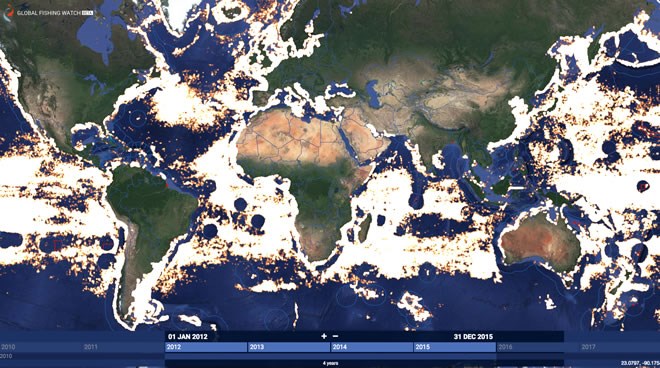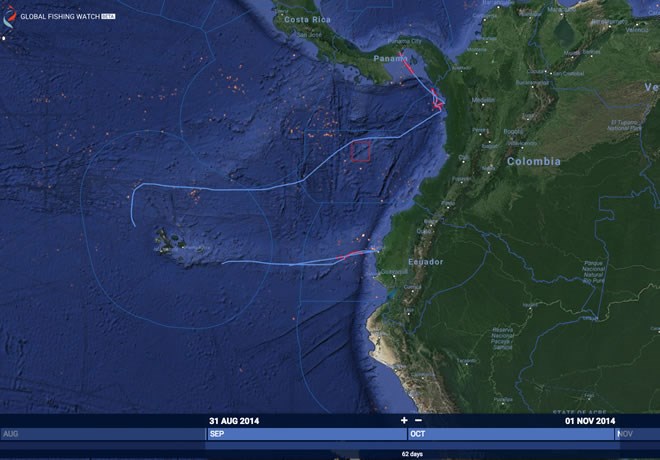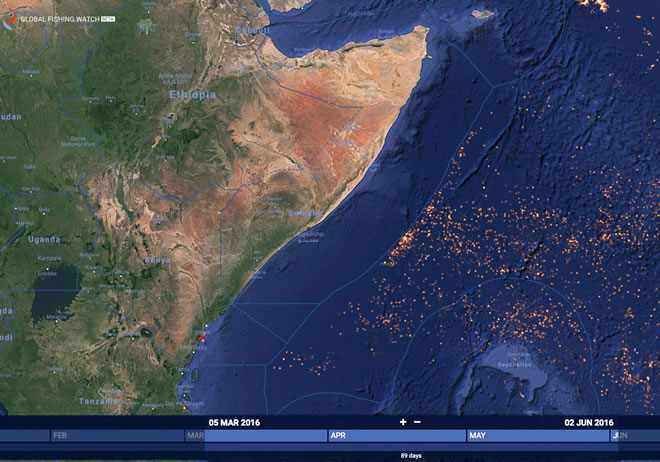
Wednesday, November 02, 2016
By Gus Lubin

Global Fishing Watch shows fishing activity around the world. COURTESY Global Fishing Watch
The island nation of Kiribati suspected that Marshalls 203 had violated its recently created no-fishing zone, but it didn’t have sufficient proof. That’s where Global Fishing Watch came in.
The non-profit, created by sea conservation group Oceana, environmental satellite imaging non-profit SkyTruth, and Google, identifies fishing boats by analyzing Automatic Identification Signals (AIS). It analyzes the movement of vessels to predict when they are fishing.
In the case of Marshalls 203, it provided unmistakable imagery that showed the boat fishing in the protected zone.
"When we provided this picture and they showed it to the vessel captain, he realized he was busted," said Jackie Savitz, Oceana’s Vice President of Global Fishing Watch.
Kirbati used this imagery to force the shipping company to pay $2 million last year.
Global Fishing Watch, which features a online tool that anyone can use for free, has some blind spots. Among them, some ships, notably smaller ones, are not required to broadcast AIS data. Also, ships engaged in illegal activity might turn it off.
Sometimes blips in AIS transmission can be used to identify suspicious activity. Savitz pointed out one ship that had dropped off the map while passing through the Galapagos exclusive economic zone — a clear red flag.

A fishing boat (light blue line) turns off its AIS signal while passing through the Galapagos exclusive economic zone (dark blue line). Global Fishing Watch
The limits of AIS make it hard to identify illegal fishing off, say, the coast of Somalia. By all reports, it is extensive there, but Global Fishing Watch shows all ships "holding the line"—i.e., going up to the restricted zone but not crossing in.
It’s worth noting, however, that the shipping industry says ships can turn off AIS when passing through that piracy risk area if they think it will make them more vulnerable to pirates.

Global Fishing Watch can also be used to spot potential transshipping, which involves ships illegally offloading their catch onto other ships.
Savitz pointed to one vessel off the coast of Chile that regularly made suspicious jaunts outside of the Chilean fishing zone.
In the future, Global Fishing Watch hopes to add new data to expand tracking. It also hopes to develop new machine-learning algorithms to identify suspicious behavior like transshipping and AIS on-off events.
Governments and other clients could use this data to aid enforcement.
"It’s possible that we could do analysis that identifies lists of suspicious vessels that countries could use at their ports," Savitz said. "We’re not saying that these ships are doing anything illegal, but this information could be used to decide which ships to look closer at."
Global Fishing Watch could also be used to support sustainable fishing practices. For instance, companies that certify sustainable fishing might require that ships stay visible to AIS or other tracking systems the whole time they sail.
Illegal fishing around the world is worth as much as $24 billion every year, according academic estimates.